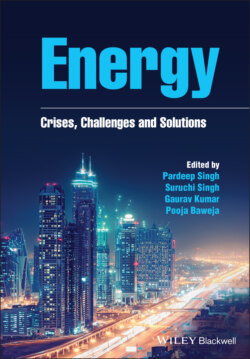Читать книгу Energy - Группа авторов - Страница 19
1.6 Cleaner Alternatives to Coal to Alleviate Climate Change 1.6.1 Carbon Sequestering and Clean Coal
ОглавлениеIn order to achieve carbon sequestration, the focus should be on planting trees, reducing deforestation and managing land on a global scale, keeping in mind the human rights and livelihoods of poor people living in forest environments, so as not to threaten their lives through such plantations. Furthermore, micro‐algae have been produced to absorb more than 80% of CO2 emissions from power plants and other greenhouse sources and can therefore be used to generate liquid fuel at an annual rate of 10,000 gal per acre (Makhijani 2008).
According to common knowledge, ‘Green coal’ has not yet existed, so there should be no dependence on it. It will, however, become available only after 2020 since the climate crisis is already overwhelming. Even if the goal of clean coal is reached, it will be costly and cost about 25% more, and it would also be very difficult to track.
The extreme constraints and attention paid by organizations such as the World Bank to the availability of clean coal and coal efficiency are major obstacles to developing countries trapping them in the dirty energy development loop, a colossal mistake that developed countries pay dearly for. China has already surpassed the United States and, after 2010, will become the world’s biggest consumer of oil. For more than 80% of its carbon emissions, China relies on coal. Every week, it opens more than two new 600 MW coal‐fired power plants (Martinot and Junfeng 2007), and neither of them can be easily equipped with modern technology for carbon sequestration. This is the essential issue that about 15 000 metric tonnes of CO2 are generated every day by each coal plant. In order to achieve carbon sequestration, the focus should be on planting trees, reducing deforestation and managing land on a global scale, keeping in mind the human rights and livelihoods of poor people living in forest environments, so as not to threaten their lives through such plantations. Furthermore, micro‐algae have been produced to absorb more than 80% of CO2 emissions from power plants and other greenhouse sources and can therefore be used to generate liquid fuel at an annual rate of 10,000 gal per acre (Makhijani 2008).
Contrary to common knowledge, ‘clean coal’ is not yet in operation, so there should be no dependency on it. However, it will only become available after 2020 if the climate crisis is already overwhelming. In any case, it would be costly and cost about 25% more, even though the clean coal goal was met, and it would also be very difficult to track.
